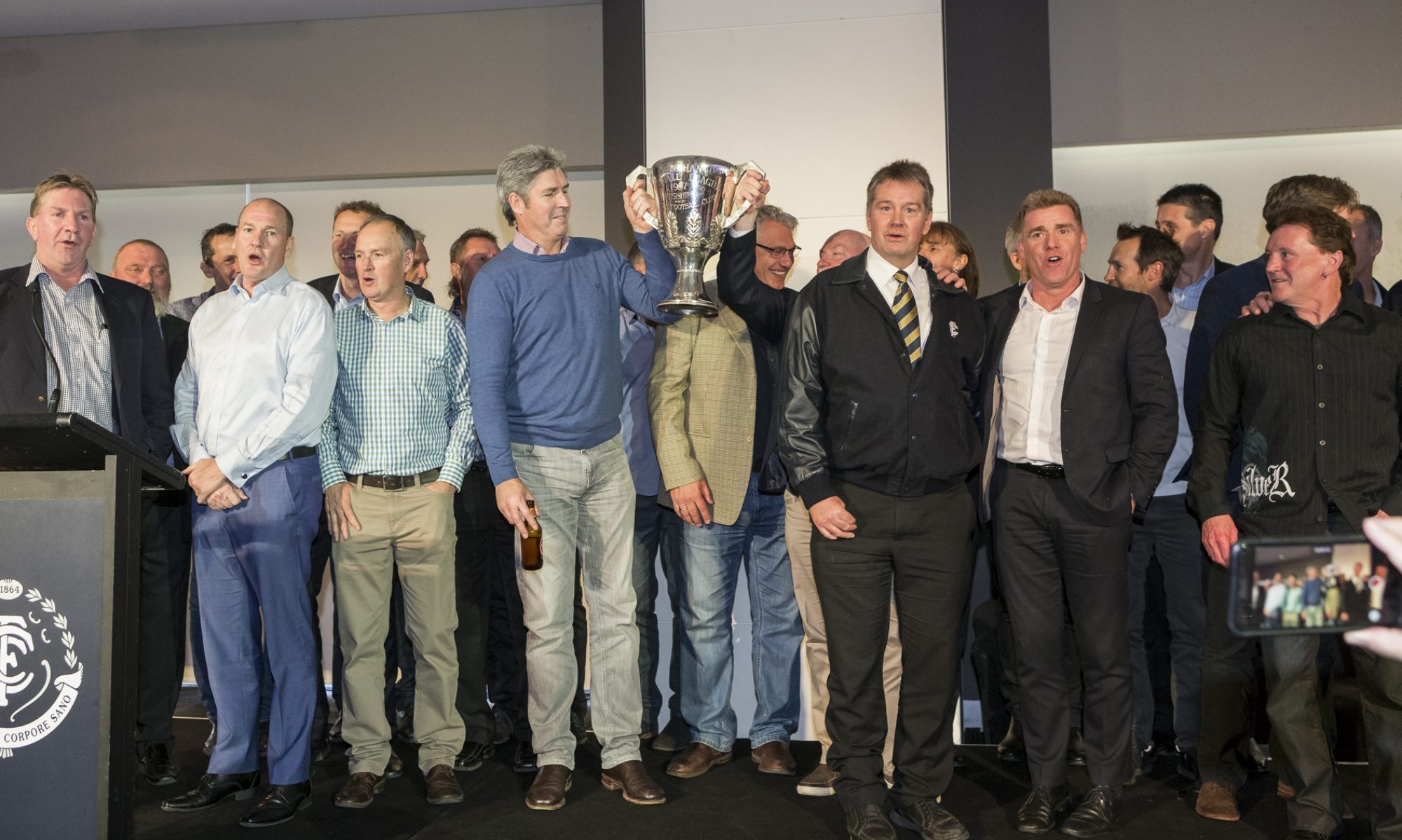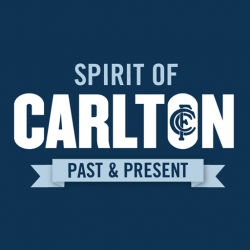Ian Collins
 Career : 1961 – 1971
Career : 1961 – 1971
Debut : Round 1, 1961 vs St Kilda, aged 18 years, 173 days
Carlton Player No. 737
Games : 161
Goals : 49
Last Game : Round 22, 1971 vs Collingwood, aged 28 years, 308 days
Guernsey No. 19
Height : 175 cm ( 5 ft. 9 in.)
Weight : 73.5 kg (11 stone, 8 lbs.)
DOB : 24 October, 1942
Premiership Player 1968
Carlton Hall of Fame (2001)
President: 2003 – 2006
A courageous, uncompromising back pocket in the Blues’ 1968 Premiership team, Ian Collins went on to serve as Secretary-Manager and President through some of Carlton Football Club’s most successful, and later, most turbulent times.
After rejecting overtures from St Kilda and Melbourne, Collins arrived at Princes Park in 1960. He was widely regarded as a ready-made league footballer following an impressive junior career at his home town of Sale in Gippsland, from where he had starred in various representative teams as a quick and skilful centreman or half-forward flanker. At 175 cm and 74 kg he struggled at first to cement a regular place in a team not short of smaller, pacey types, until he was tried as a back pocket in his second year. Almost immediately, he made the last line his territory, and began forging a reputation as a courageous and difficult opponent in the number 19 guernsey.
In 1962 Carlton made the finals after many years in the football wilderness, and played Geelong in the Preliminary Final for the right to meet Essendon for the flag. In a willing, sometimes spiteful encounter, Collins suffered a broken jaw and a split tongue. Carlton won the match, so Collins was determined he would be playing the following week. Somehow, he managed to conceal the severity of the injury, and was far from our worst performer. Essendon, however proved too good.
Six years on, Carlton met the Bombers again for the 1968 Premiership, and turned the tables to claim our first flag in 21 seasons. Collins was solid as always on a great day when wingman Garry Crane was the Blues’ best in a hard-fought three point win. Alongside Collins at full-back as usual was Wes Lofts, and the duo were a daunting proposition. Later, Lofts served as the Blues’ Chairman of Selectors for many years, and he and Collins forged a strong partnership at board level.
Collins might well have collected a second Premiership medal if he had not suffered a serious achilles tendon tear that cost him the entire 1970 football season. While it was a severe blow to his sporting aspirations, the forced holiday did have an upside, in that “Collo” was at least able to complete his tertiary studies in accountancy. The skills he acquired were to prove more than handy when he announced his retirement from league football following the 1971 final series. He was 29, with 161 games and 49 goals to his credit. He spent the following season of 1972 as captain-coach of VFA club Port Melbourne (where one of his players was his former coach at Carlton, Ron Barassi), then hung up his boots for good to prepare for bigger things.
In 1981 Collo was appointed Secretary-Manager of the Carlton Football Club, a position he filled with distinction for twelve years. In this time the Blues won three more flags. In 1993 he became the AFL Director of Football Operations, and in 1999 was appointed CEO of Stadium Operations Ltd, responsible for the AFL’s showpiece Docklands Stadium (Telstra Dome). He was elected to the Carlton Hall of Fame in 2001, and awarded an Order of Australia for his service to the game.
Peter Sartori
 Career : 1987 – 1991
Career : 1987 – 1991
Debut : Round 1, 1987 vs Hawthorn, aged 22 years, 154 days
Carlton Player No. 941
Games : 57
Goals : 114
Last Game : Round 24, 1991 vs Richmond, aged 26 years, 310 days
Guernsey No. 18
Height : 195 cm (6 ft. 4 in.)
Weight : 92 kg ( 14 stone, 7 lbs.)
DOB : 24 October, 1964
Another in a long list of VFL/AFL footballers in the category of “could have been anything, but for injury,” West Australian Peter Sartori spent eight seasons with Carlton and Fitzroy between 1987 and 1994, yet managed only 77 games all up. A tall ruckman-forward, he had rare ability and all the physical attributes needed, but sadly, his body let him down with monotonous regularity.
Sartori was just 17 when he played his first senior match for Swan Districts, and 18 when he suffered his first major injury – a ruptured kidney – which kept him out of the Swans’ 1982 Premiership side. When he did eventually return to the field however, he clicked into rare form. His marking skill, versatility and intuitive reading of the play made him a driving force in both of the Swans’ follow-up flag victories in 1983 and ’84. By 1986 he had represented WA twice, won his club’s Best and Fairest award, and well and truly caught the eye of just about every AFL club.
Carlton won the contest for his signature, and Sartori came to Princes Park to augment a growing contingent of star forwards with WA origins – a group that would eventually include Peter Bosustow, Ross Ditchburn, Warren Ralph, Jon Dorotich, Richard Dennis and Earl Spalding. Yet competition for places was fierce, as the club also had Stephen Kernahan, Simon Minton-Connell and Warren McKenzie on its books at the time.
Sartori was assigned guernsey number 18, and made his debut for the Blues in round 1, 1987, against Hawthorn at Princes Park. His first half-dozen games were rather unremarkable, before he strained a hamstring to cut short his progress, and didn’t return to the seniors until late in the season. Then, in only his eighth game, the big Sandgroper showed what he was capable of when he and his captain, Stephen Kernahan went on a rampage against Geelong at Kardinia Park, and kicked a massive 15 goals between them. ‘Sticks’ booted eight, and Sartori contributed seven in a display of forward power that had Carlton supporters in rapture.
That joy lasted for only a fortnight – until the first week of the finals. After a torrid year, the Blues had claimed the minor premiership, and met Hawthorn in what proved to be the defining match of the season in the second Semi Final. Trailing by 15 points at the main break, Carlton stormed home to win by that same margin – but at a cost. Sartori’s hamstring tore again, and his year was prematurely ended. He had kicked one goal on the day, and set up two others with skilful palming of the ball to Johnston and Naley. The Johnston goal came from a clever flip over the back of the pack to the Dominator, who goaled with a right foot snap. In the following quarter at the main scoreboard end, Sartori deftly palmed the ball to Naley in heavy traffic, and his clever snap brought up another telling goal. Both of those scores were the direct result of clever ruckwork by the big West Australian, and showed that it was a much-underrated facet of his game. However, that was all academic in the end, because he could only watch on in frustration two weeks later, when his team decisively beat the Hawks yet again in the Grand Final.
Thanks to the Blueseum for player profiles and pics.


























